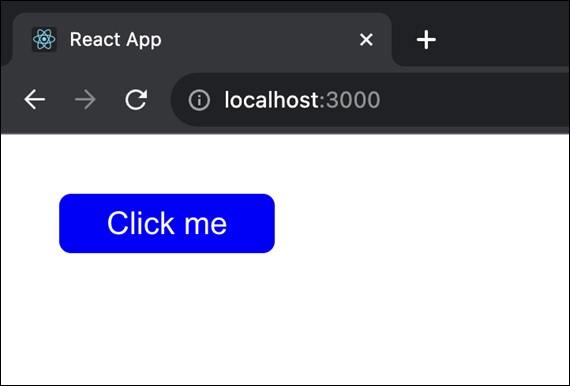
- ReactJS 教程
- ReactJS - 首頁
- ReactJS - 簡介
- ReactJS - 路線圖
- ReactJS - 安裝
- ReactJS - 特性
- ReactJS - 優點與缺點
- ReactJS - 架構
- ReactJS - 建立 React 應用
- ReactJS - JSX
- ReactJS - 元件
- ReactJS - 巢狀元件
- ReactJS - 使用新建立的元件
- ReactJS - 元件集合
- ReactJS - 樣式
- ReactJS - 屬性 (props)
- ReactJS - 使用屬性建立元件
- ReactJS - props 驗證
- ReactJS - 建構函式
- ReactJS - 元件生命週期
- ReactJS - 事件管理
- ReactJS - 建立一個事件感知元件
- ReactJS - 在 Expense Manager APP 中引入事件
- ReactJS - 狀態管理
- ReactJS - 狀態管理 API
- ReactJS - 無狀態元件
- ReactJS - 使用 React Hooks 進行狀態管理
- ReactJS - 使用 React Hooks 進行元件生命週期管理
- ReactJS - 佈局元件
- ReactJS - 分頁
- ReactJS - Material UI
- ReactJS - Http 客戶端程式設計
- ReactJS - 表單程式設計
- ReactJS - 受控元件
- ReactJS - 非受控元件
- ReactJS - Formik
- ReactJS - 條件渲染
- ReactJS - 列表
- ReactJS - Keys
- ReactJS - 路由
- ReactJS - Redux
- ReactJS - 動畫
- ReactJS - Bootstrap
- ReactJS - Map
- ReactJS - 表格
- ReactJS - 使用 Flux 管理狀態
- ReactJS - 測試
- ReactJS - CLI 命令
- ReactJS - 構建和部署
- ReactJS - 示例
- Hooks
- ReactJS - Hooks 簡介
- ReactJS - 使用 useState
- ReactJS - 使用 useEffect
- ReactJS - 使用 useContext
- ReactJS - 使用 useRef
- ReactJS - 使用 useReducer
- ReactJS - 使用 useCallback
- ReactJS - 使用 useMemo
- ReactJS - 自定義 Hooks
- ReactJS 高階
- ReactJS - 可訪問性
- ReactJS - 程式碼分割
- ReactJS - Context
- ReactJS - 錯誤邊界
- ReactJS - 轉發 Refs
- ReactJS - Fragments
- ReactJS - 高階元件
- ReactJS - 與其他庫整合
- ReactJS - 效能最佳化
- ReactJS - Profiler API
- ReactJS - Portals
- ReactJS - 無 ES6 ECMAScript 的 React
- ReactJS - 無 JSX 的 React
- ReactJS - 協調
- ReactJS - Refs 和 DOM
- ReactJS - Render Props
- ReactJS - 靜態型別檢查
- ReactJS - Strict Mode
- ReactJS - Web Components
- 其他概念
- ReactJS - 日期選擇器
- ReactJS - Helmet
- ReactJS - 內聯樣式
- ReactJS - PropTypes
- ReactJS - BrowserRouter
- ReactJS - DOM
- ReactJS - 走馬燈
- ReactJS - 圖示
- ReactJS - 表單元件
- ReactJS - 參考 API
- ReactJS 有用資源
- ReactJS - 快速指南
- ReactJS - 有用資源
- ReactJS - 討論
ReactJS - 靜態 defaultProps 屬性
React 是一個流行的使用者介面開發庫。有時在建立 React 應用時,我們可能希望為某些屬性設定預設設定。“defaultProps”的概念在這種情況下就派上用場了。
什麼是 defaultProps?
DefaultProps 是 React 的一個特性,允許我們為元件的屬性 (或 props) 提供預設值。當未提供 prop、prop 未定義或缺少 prop 時,將使用這些預設值。需要注意的是,如果 prop 顯式設定為 null,則不會應用 defaultProps。
defaultProps 的用法
class Button extends Component {
static defaultProps = {
color: 'blue'
};
render() {
return <button className={this.props.color}>Click me</button>;
}
}
在此程式碼中,我們有一個 Button 元件,它接受一個 'color' prop。如果未提供 'color' prop 或其未定義,defaultProps 會介入並預設將 'color' prop 設定為 'blue'。
defaultProps 實踐示例
如果沒有提供 'color' prop,Button 元件將預設設定為 'blue'。
<Button />
{/* The color is "blue" */}
即使我們將 'color' prop 直接設定為 undefined,defaultProps 仍然生效,將 'color' 的預設值設定為 'blue'。
<Button color={undefined} />
{/* The color is "blue" */}
如果我們將 'color' prop 更改為 null,defaultProps 不會覆蓋它,'color' 將為 null。
<Button color={null} />
{/* The color is null */}
如果我們為 'color' prop 提供一個值,則將使用該值而不是預設值。
<Button color="red" />
{/* The color is "red" */}
示例
示例 - Button 元件應用
我們將建立一個 React 應用,其中我們將顯示一個具有藍色顏色的按鈕元件,以展示 defaultProps 的用法。
現在開啟專案,並使用程式碼編輯器導航到專案目錄中的 src 資料夾。替換 App.js 檔案中的以下程式碼:
import React, { Component } from 'react';
import './App.css'; // Import the CSS file
class Button extends Component {
static defaultProps = {
color: 'blue'
};
render() {
return <button className={`button ${this.props.color}`}>Click me</button>;
}
}
class App extends Component {
render() {
return (
<div className="App">
<Button />
</div>
);
}
}
export default App;
App.css
.button {
background-color: rgb(119, 163, 208);
color: white;
padding: 5px 20px;
border: 2px;
margin-top: 25px;
border-radius: 5px;
cursor: pointer;
}
.blue {
background-color: blue;
}
輸出

示例 - 簡單計數器應用
在這個應用中,我們將顯示一個從指定初始值(預設為 0)開始的計數器。使用者可以點選一個按鈕來增加計數器。此應用將向我們展示如何使用靜態 defaultProps 為某些屬性提供預設值。此應用的程式碼如下:
import React, { Component } from 'react';
class Counter extends Component {
static defaultProps = {
initialValue: 0,
};
constructor(props) {
super(props);
this.state = {
count: this.props.initialValue,
};
}
increment = () => {
this.setState((prevState) => ({ count: prevState.count + 1 }));
};
render() {
return (
<div>
<h2>Counter App</h2>
<p>Count: {this.state.count}</p>
<button onClick={this.increment}>Increment</button>
</div>
);
}
}
export default Counter;
輸出

示例 - 切換開關應用
在這個應用中,我們將提供一個可以開啟或關閉的切換開關。我們將初始狀態設定為開啟或關閉(預設為關閉)。使用者可以點選一個按鈕來切換開關。此應用的程式碼如下:
import React, { Component } from 'react';
class ToggleSwitch extends Component {
static defaultProps = {
defaultOn: false,
};
constructor(props) {
super(props);
this.state = {
isOn: this.props.defaultOn,
};
}
toggle = () => {
this.setState((prevState) => ({ isOn: !prevState.isOn }));
};
render() {
return (
<div>
<h2>Toggle Switch App</h2>
<p>Switch is {this.state.isOn ? 'ON' : 'OFF'}</p>
<button onClick={this.toggle}>Toggle</button>
</div>
);
}
}
export default ToggleSwitch;
輸出

在上面的輸出中,我們可以看到有一個名為“Toggle”的按鈕,當我們點選它時,訊息將根據條件更改。如果訊息是“Switch is OFF”,那麼點選按鈕後,訊息將更改為“Switch is ON”。
總結
defaultProps 是 React 中一個有用的特性,它改進了對元件屬性預設值的處理。它確保即使缺少或未定義某些 props,我們的元件也能有效地工作。透過定義預設值,我們可以使程式碼更簡潔、更易於使用。